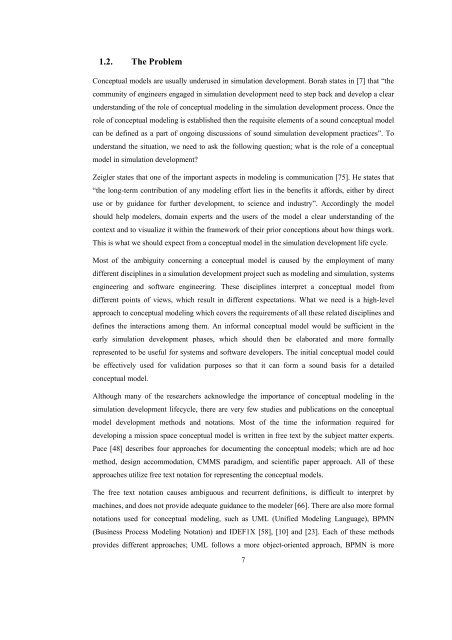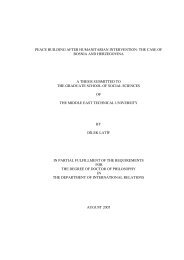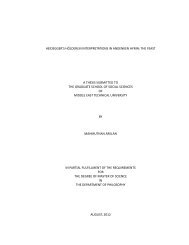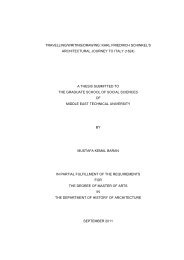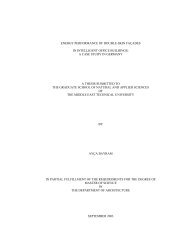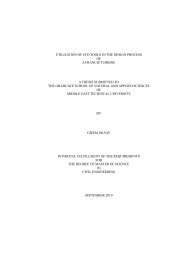a framework for developing conceptual models of the mission space ...
a framework for developing conceptual models of the mission space ...
a framework for developing conceptual models of the mission space ...
You also want an ePaper? Increase the reach of your titles
YUMPU automatically turns print PDFs into web optimized ePapers that Google loves.
1.2. The Problem<br />
Conceptual <strong>models</strong> are usually underused in simulation development. Borah states in [7] that “<strong>the</strong><br />
community <strong>of</strong> engineers engaged in simulation development need to step back and develop a clear<br />
understanding <strong>of</strong> <strong>the</strong> role <strong>of</strong> <strong>conceptual</strong> modeling in <strong>the</strong> simulation development process. Once <strong>the</strong><br />
role <strong>of</strong> <strong>conceptual</strong> modeling is established <strong>the</strong>n <strong>the</strong> requisite elements <strong>of</strong> a sound <strong>conceptual</strong> model<br />
can be defined as a part <strong>of</strong> ongoing discussions <strong>of</strong> sound simulation development practices”. To<br />
understand <strong>the</strong> situation, we need to ask <strong>the</strong> following question; what is <strong>the</strong> role <strong>of</strong> a <strong>conceptual</strong><br />
model in simulation development?<br />
Zeigler states that one <strong>of</strong> <strong>the</strong> important aspects in modeling is communication [75]. He states that<br />
“<strong>the</strong> long-term contribution <strong>of</strong> any modeling ef<strong>for</strong>t lies in <strong>the</strong> benefits it af<strong>for</strong>ds, ei<strong>the</strong>r by direct<br />
use or by guidance <strong>for</strong> fur<strong>the</strong>r development, to science and industry”. Accordingly <strong>the</strong> model<br />
should help modelers, domain experts and <strong>the</strong> users <strong>of</strong> <strong>the</strong> model a clear understanding <strong>of</strong> <strong>the</strong><br />
context and to visualize it within <strong>the</strong> <strong>framework</strong> <strong>of</strong> <strong>the</strong>ir prior conceptions about how things work.<br />
This is what we should expect from a <strong>conceptual</strong> model in <strong>the</strong> simulation development life cycle.<br />
Most <strong>of</strong> <strong>the</strong> ambiguity concerning a <strong>conceptual</strong> model is caused by <strong>the</strong> employment <strong>of</strong> many<br />
different disciplines in a simulation development project such as modeling and simulation, systems<br />
engineering and s<strong>of</strong>tware engineering. These disciplines interpret a <strong>conceptual</strong> model from<br />
different points <strong>of</strong> views, which result in different expectations. What we need is a high-level<br />
approach to <strong>conceptual</strong> modeling which covers <strong>the</strong> requirements <strong>of</strong> all <strong>the</strong>se related disciplines and<br />
defines <strong>the</strong> interactions among <strong>the</strong>m. An in<strong>for</strong>mal <strong>conceptual</strong> model would be sufficient in <strong>the</strong><br />
early simulation development phases, which should <strong>the</strong>n be elaborated and more <strong>for</strong>mally<br />
represented to be useful <strong>for</strong> systems and s<strong>of</strong>tware developers. The initial <strong>conceptual</strong> model could<br />
be effectively used <strong>for</strong> validation purposes so that it can <strong>for</strong>m a sound basis <strong>for</strong> a detailed<br />
<strong>conceptual</strong> model.<br />
Although many <strong>of</strong> <strong>the</strong> researchers acknowledge <strong>the</strong> importance <strong>of</strong> <strong>conceptual</strong> modeling in <strong>the</strong><br />
simulation development lifecycle, <strong>the</strong>re are very few studies and publications on <strong>the</strong> <strong>conceptual</strong><br />
model development methods and notations. Most <strong>of</strong> <strong>the</strong> time <strong>the</strong> in<strong>for</strong>mation required <strong>for</strong><br />
<strong>developing</strong> a <strong>mission</strong> <strong>space</strong> <strong>conceptual</strong> model is written in free text by <strong>the</strong> subject matter experts.<br />
Pace [48] describes four approaches <strong>for</strong> documenting <strong>the</strong> <strong>conceptual</strong> <strong>models</strong>; which are ad hoc<br />
method, design accommodation, CMMS paradigm, and scientific paper approach. All <strong>of</strong> <strong>the</strong>se<br />
approaches utilize free text notation <strong>for</strong> representing <strong>the</strong> <strong>conceptual</strong> <strong>models</strong>.<br />
The free text notation causes ambiguous and recurrent definitions, is difficult to interpret by<br />
machines, and does not provide adequate guidance to <strong>the</strong> modeler [66]. There are also more <strong>for</strong>mal<br />
notations used <strong>for</strong> <strong>conceptual</strong> modeling, such as UML (Unified Modeling Language), BPMN<br />
(Business Process Modeling Notation) and IDEF1X [58], [10] and [23]. Each <strong>of</strong> <strong>the</strong>se methods<br />
provides different approaches; UML follows a more object-oriented approach, BPMN is more<br />
7


